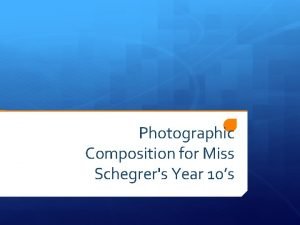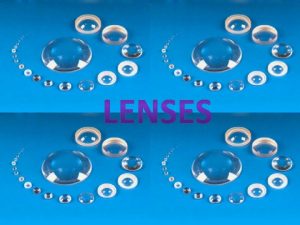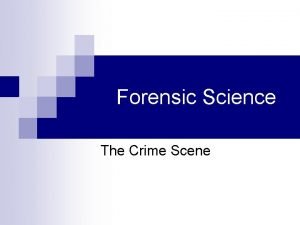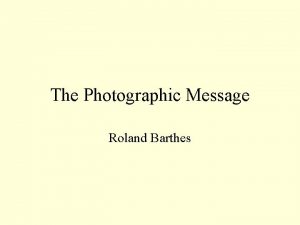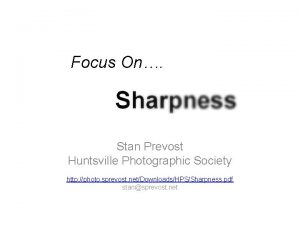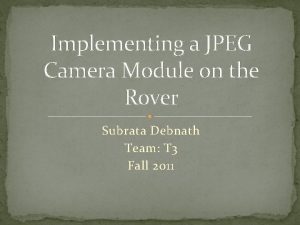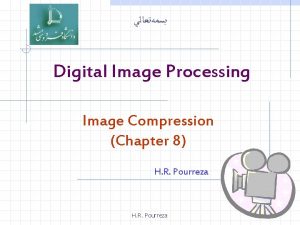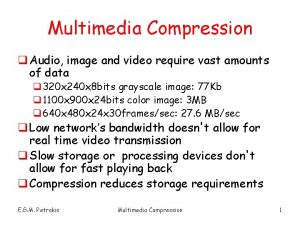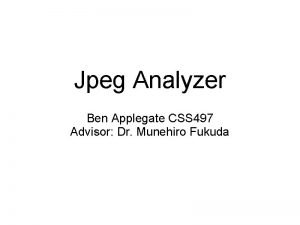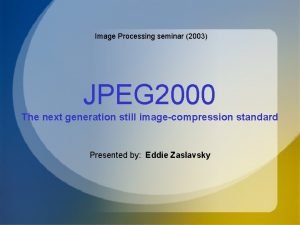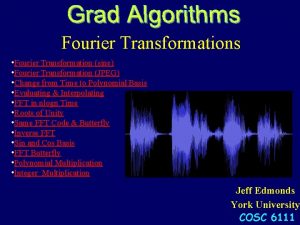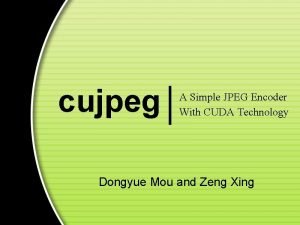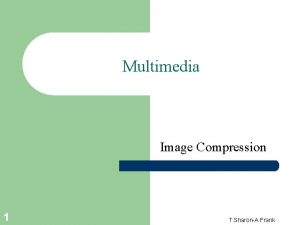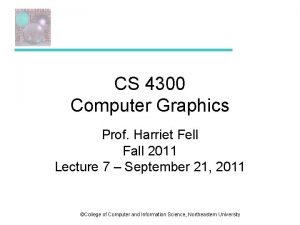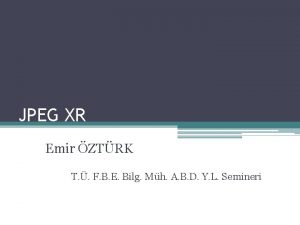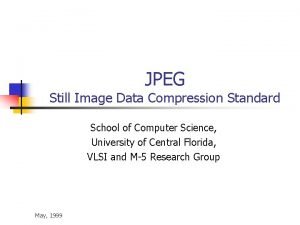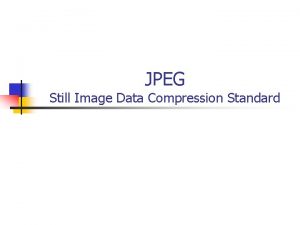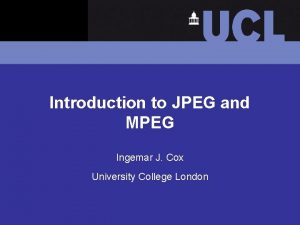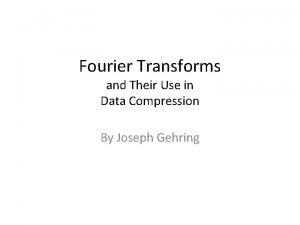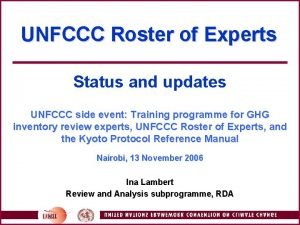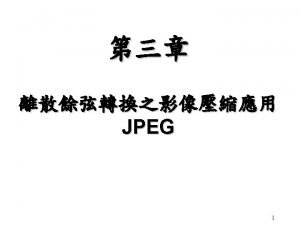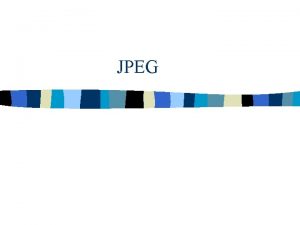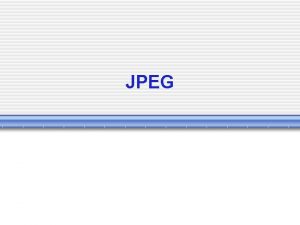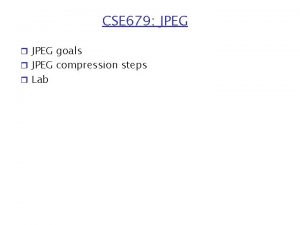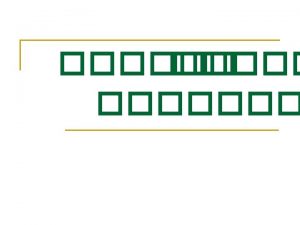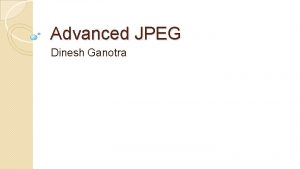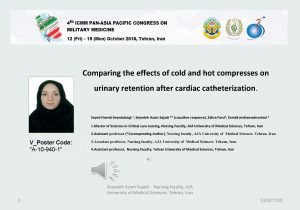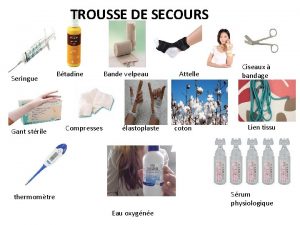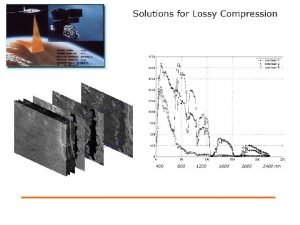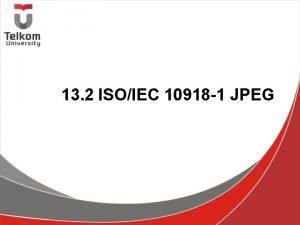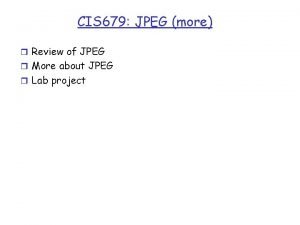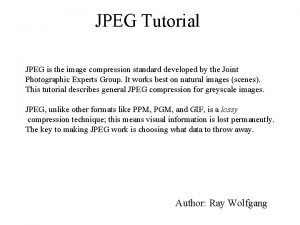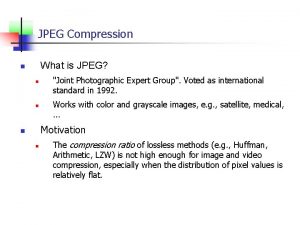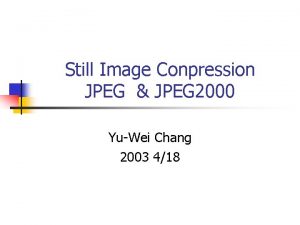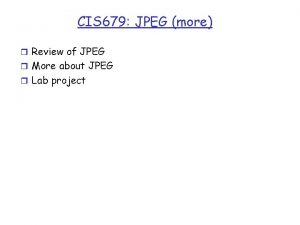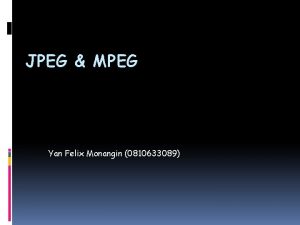JPEG JPEG is Joint Photographic Experts Group compresses





































- Slides: 37

JPEG “JPEG” is Joint Photographic Experts Group. compresses pictures which don't have sharp changes e. g. landscape pictures. May lose some of the data in order to compress better. Both color or grayscale images. 15.

Encoding Order Each block of 8 x 8 is treated separately. Order of blocks is: 25.

Baseline JPEG Transfer to frequency space using Discrete Cosine Transform (DCT). Quantization: Divide and round the results according to the required quality. This stage may cause some lose of data. Compress the data by a version of Canonical Huffman coding. Non-Baseline JPEG may use also Arithmetic coding. 35.

DCT The DCT is a mathematical operation that transform a set of data, which is sampled at a given sampling rate, to it's frequency components. 45.

DCT (cont. ) The first element in the result array is a simple sum of all the samples in the input array and is referred to as DC coefficient. The remaining elements in the result array each indicate the amplitude of a specific frequency component of the input array, and are known as AC coefficients. The frequency content of the sample set at each frequency is calculated by taking a weighted sum of the entire set. 55.

One dimensional DCT If u = 0 If If f(x) (the intensity of each pixel) is equal in the whole row, each F(u) which holds u>0, will be zero. F(0) will be the sum of the row’s values divided by 65.

DCT values These are the values of weight for one row in a 8 x 8 matrix (considering f(x) is 1): ResultSample Index 0 1 2 3 4 5 6 7 0 +0. 707 +0. 707 1 +0. 981 +0. 831 +0. 556 +0. 195 -0. 556 -0. 831 -0. 981 2 +0. 924 +0. 383 -0. 924 -0. 383 +0. 924 3 +0. 831 -0. 195 -0. 981 -0. 556 +0. 981 +0. 195 -0. 831 4 +0. 707 -0. 707 +0. 707 5 +0. 556 -0. 981 +0. 195 +0. 831 -0. 195 +0. 981 -0. 556 6 +0. 383 -0. 924 +0. 924 -0. 383 +0. 924 -0. 924 +0. 383 7 +0. 195 -0. 556 +0. 831 -0. 981 +0. 981 -0. 831 +0. 556 -0. 195 75.

Two dimensional DCT one-dimensional DCT is applied separately to each row of eight pixels. The result will be eight rows of frequency coefficients. These 64 coefficients are then taken as eight column. The first column will contain all DC coefficients, the second column will contain the first AC coefficient from each row, and so on. One-dimensional DCT is applied to each of these columns. 85.

DCT formula Index 0, 0 contains the DC of the DCs. This value is called the DC of the 8 x 8 matrix. 95.

Biased Values JPEG allows samples of 8 bits or 12 bits. All samples within the same source image must have the same precision. The samples are shifted from unsigned integers with range [0, 2 p-1] to signed integers with range [-2 p-1, 2 p-1 -1], by reducing 2 p-1 from the original values, where p can be either 8 or 12. These biased values are sent to the DCT function. 105.

Example 139 144 149 153 155 155 235. 6 -1. 0 -12. 1 -5. 2 2. 1 -1. 7 -2. 7 1. 3 16 11 10 16 24 40 51 61 144 151 153 156 159 156 156 -22. 6 -17. 5 -6. 2 -3. 2 -2. 9 -0. 1 0. 4 -1. 2 12 12 14 19 26 58 60 55 150 155 160 163 158 156 156 -10. 9 -9. 3 -1. 6 1. 5 0. 2 -0. 9 -0. 6 -0. 1 14 13 16 24 40 57 69 56 159 161 162 160 159 159 -7. 1 -1. 9 0. 2 1. 5 0. 9 -0. 1 0. 0 0. 3 14 17 22 29 51 87 80 62 159 160 161 162 155 155 -0. 6 -0. 8 1. 5 1. 6 -0. 1 -0. 7 0. 6 1. 3 18 22 37 56 68 109 103 77 161 161 160 157 157 1. 8 -0. 2 1. 6 -0. 3 -0. 8 1. 5 1. 0 -1. 0 24 35 55 64 81 104 113 92 162 161 163 162 157 157 -1. 3 -0. 4 -0. 3 -1. 5 -0. 5 1. 7 1. 1 -0. 8 49 64 78 87 103 121 120 101 162 161 163 158 158 -2. 6 1. 6 -3. 8 -1. 8 1. 9 1. 2 -0. 6 -0. 4 72 92 95 98 112 100 103 99 (a) Source image samples (b) forward DCT coefficients 115. (c) quantization table

Example (cont. ) 0 -1 0 0 0 240 0 -10 0 0 144 146 149 152 154 156 156 -2 -1 0 0 0 -24 -12 0 0 0 148 150 152 154 156 156 -1 -1 0 0 0 -14 -13 0 0 0 155 156 157 158 157 156 155 0 0 0 0 160 161 162 161 159 157 155 0 0 0 0 163 164 163 162 160 158 156 0 0 0 0 163 164 164 162 160 158 157 0 0 0 0 160 161 162 162 161 159 158 0 0 0 0 158 159 161 162 161 159 158 15 (a) normalized quantized coefficients (b) denormalized quantized coefficients 125. (c) reconstructed image samples

JPEG quality 1% 3203 bytes 5% 11832 bytes 20% 32155 bytes 100% 284179 bytes 135.

Lower qualities Sharp changes are smeared through several pixels. 145.

Zig-Zag Sequence The entropy encoder looks on the coefficients in this order: 155.

An example for compression 20 1 0 0 0 0 3 0 0 0 0 2 - 0 0 0 0 0 0 0 0 0 0 JPEG switches zeros and ones in negative numbers 100 101 00 3 5 165. This matrix is after DCT and after Quantization. Different Huffman codes For DC and AC values. Suppose last block's DC value was 15. 1 11111001 11 1111111000 01 1010 0, 1 1 2, 2 3 4, 2 -2 EOB

JPEG’s Huffman standard tables A special Huffman tree can be built for each image. These tables (in this and next slide) are the default ones: 175.

AC standard table 185.

Error in Baseline JPEG 3 blocks as above. Synchronization when an EOB decoded correctly. erroneous decoding 100 101 00 1 11111001 11 1111111000 01 1010 2 100 101 00 -3 EOB synchronization point 1 11111001 11 1111111000 01 1010 2 100 101 00 -2 0, 2 3 1, 1 1 1, 8 165 1 11111001 11 1111111000 01 1010 0, 1 1 2, 2 195. 3 4, 2 -2 EOB

An example Least significant bit of byte 10000 in this picture changed from 0 to 1. Original picture Edited picture 205.

A Color Image There are some methods used in encoding color images. The most common one is YUV. Y is the luminance component, while U and V are color difference components. RGB is also permitted. One data unit for Red, one for Green and one for Blue. The YUV components are interleaved together within the compressed data. Each component’s data unit, can be a block of 8 x 8, but can be larger. 215.

YUV Picture with all the components – YUV Picture with only Y component. Picture with only U component. Picture with only V component. 225.

Huffman’s tree The default Huffman table for the chrominance components of an image: There is also a different tree for the chrominance AC components 235.

Grayscale vs. Color In fact, for comparable visual quality, a grayscale image needs perhaps 25% less space than a color image. Certainly, not the 66% less that you might naively expect. You can afford to lose a lot more information in the chrominance components than you can in the luminance component: the human eye is not as sensitive to high-frequency chrominance information as it is to high-frequency luminance. The luminance component is left at full resolution, while the chrominance components are often reduced 2: 1 horizontally and either 2: 1 or 1: 1 (no change) vertically. 245.

Error in a color picture Least significant bit of byte 10000 in this picture changed from 0 to 1. Since the YUV components are interleaved together within the compressed data, components can be switched. In this picture the chrominance component was reduced 2: 1 horizontally and 2: 1 vertically. 255.

Progressive Mode The progressive mode is intended to support real-time transmission of images. With each scan, the decoder can produce a higher-quality rendition of the image. Thus a low-quality preview can be sent very quickly, then refined as time allows. The total space needed is roughly the same as for a baseline JPEG image of the same final quality. A buffer is needed in the decoder. 265.

Progressive Mode The image is encoded in multiple scans rather than in a single scan. Progressive Sequential 275.

More progressive modes The quantized DCT coefficients can be shown as a box: 285.

Sequential send When a nonprogressive mode is used, the sending order is: 295.

Spectral Selection First, the DCs are sent. Then the ACs are sent according to their order. 305.

Spectral Selection (cont. ) When there are just DCs, each 8 x 8 block is filled with equal pixels. 315.

Error in Spectral Selection The DCs have been shifted to left. The ACs are in the correct positions. 325.

Successive Approximation First, the MSB is sent. Then, the other lower bits are sent. 335.

Successive Approximation Since ACs are usually low, most of the MSB are zeros. Hence the picture is filled with 8 x 8 blocks with equal pixels. 345.

MPEG I - Intra frame - a frame coded as a still image, not using any past history. P - Predicted frame - predicted from the most recently reconstructed I or P frame. B - Bidirectional frame - predicted from the closest two I or P frames, one in the past and one in the future. 355.

Sequence of Frames The sequence of decoded frames usually goes like: IBBPBBPBBPBBIBBPBBPB. . . The compressed data stream ends up looking like: 0312645. . . 365.

Frames Distribution Usually, the size of a P frame is about 70% of an I frame and the size of a B frame is about 35% of an I frame. There are no more than 12 frames from I to I. This is based on a random access requirement and error recovery. The ratio of P's to B's is based on experience. 375.
 Joint jpeg
Joint jpeg Global business experts group
Global business experts group Motion pictures experts group
Motion pictures experts group What is “photographic composition”? *
What is “photographic composition”? * Photographic enlarger ray diagram
Photographic enlarger ray diagram Photographic log recorder
Photographic log recorder Photographic paradox
Photographic paradox Sketch preparer
Sketch preparer Holder of the sensitized material
Holder of the sensitized material Photographic silkscreen
Photographic silkscreen Advance auto parts near me
Advance auto parts near me Break joint vs spool joint
Break joint vs spool joint Costotransverse joint
Costotransverse joint Permanent joining methods
Permanent joining methods Memorandum joint venture method
Memorandum joint venture method Break joint vs spool joint
Break joint vs spool joint Ellipsoid joint examples
Ellipsoid joint examples Jpeg disadvantages
Jpeg disadvantages Fritzing camera
Fritzing camera Jpeg in digital image processing
Jpeg in digital image processing Mpeg vs jpeg
Mpeg vs jpeg Css analyzer
Css analyzer Jpeg 2000 compressor
Jpeg 2000 compressor Fourier basis
Fourier basis Cuda jpeg encoder
Cuda jpeg encoder Block size in block preparation step of jpeg compression is
Block size in block preparation step of jpeg compression is Jpeg to png
Jpeg to png Arm jpeg
Arm jpeg Jpegls
Jpegls Jpeg xr
Jpeg xr Jpeg: still image data compression standard
Jpeg: still image data compression standard Jpeg still image data compression standard
Jpeg still image data compression standard Ingemar j. cox
Ingemar j. cox Jpeg fourier transform
Jpeg fourier transform Dekimo experts leuven
Dekimo experts leuven Roster of experts unfccc
Roster of experts unfccc Railcar pooling experts
Railcar pooling experts Simple english experts
Simple english experts



